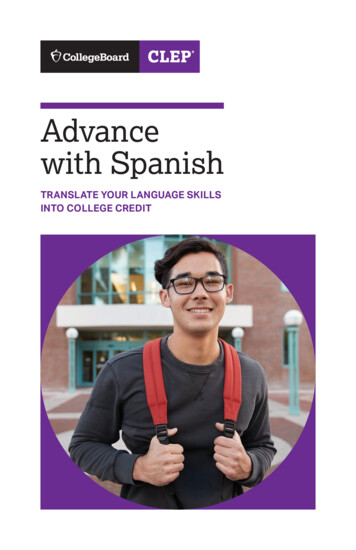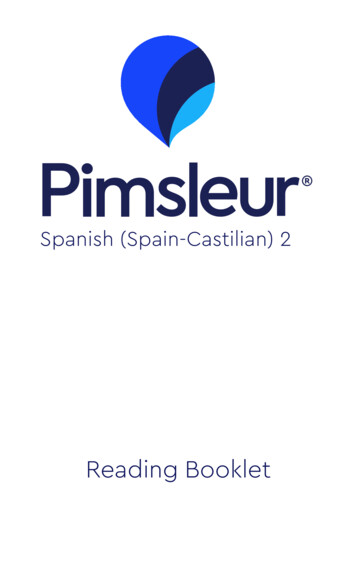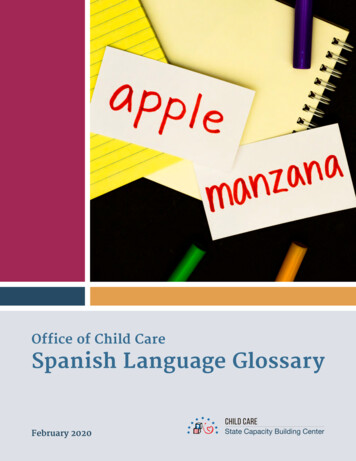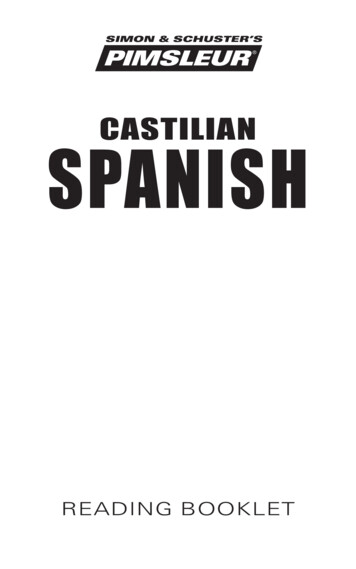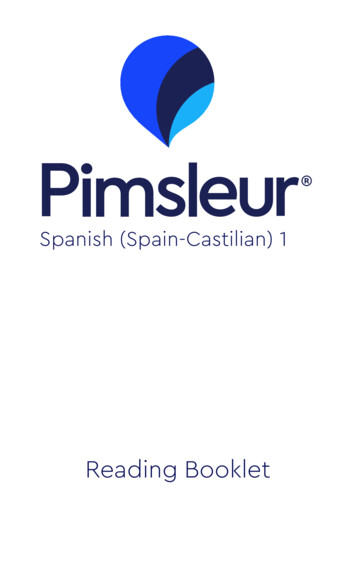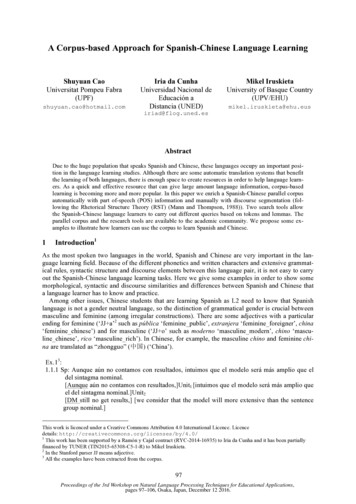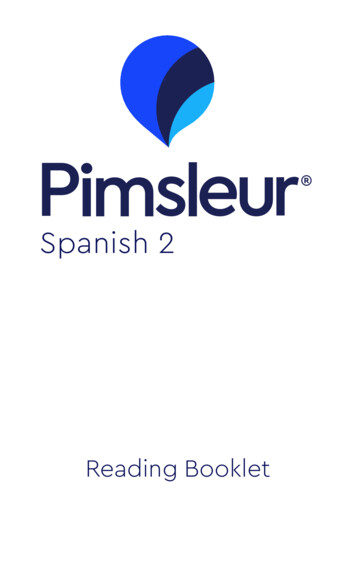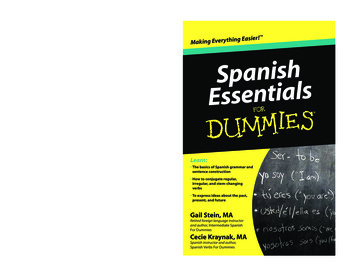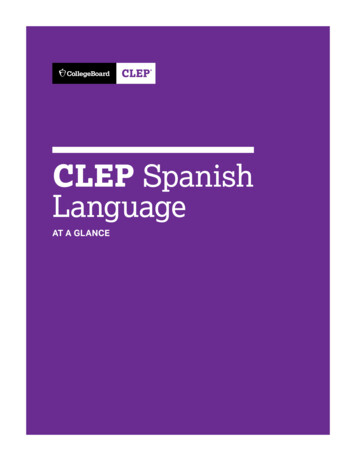
Transcription
CLEP SpanishLanguageAT A GLANCE
Description of the ExaminationStudy ResourcesThe CLEP Spanish Language examination is designedto measure knowledge and ability equivalent to that ofstudents who have completed two to three semesters ofcollege Spanish language study.Most textbooks used in college-level Spanish languagecourses cover the topics in the above outline, but theapproaches to certain topics and the emphases given tothem may differ. To prepare for the CLEP Spanish Languageexam, it is advisable to study one or more college textbooks,which can be found in most college bookstores. Whenselecting a textbook, check the table of contents againstthe knowledge and skills required for this test.The examination contains approximately 121 questions tobe answered in approximately 90 minutes. Some of theseare pretest questions that will not be scored. There are threeseparately timed sections. The three sections are weightedso that each question contributes equally to the total score.There are two Listening sections and one Reading section.Each section has its own timing requirements.§ The two Listening sections together are approximately30 minutes in length. The amount of time candidateshave to answer a question varies according to thesection and doesn’t include the time they spendlistening to the test material.§ The Reading section is 60 minutes in length.Colleges may award different amounts of credit dependingon the candidate’s test scores.Knowledge and Skills RequiredQuestions on the Spanish Language examination requirecandidates to comprehend written and spoken Spanish.The subject matter is drawn from the abilities listed below.The percentages next to the main topics indicate theapproximate percentage of exam questions on that ability.15% SECTION I: LISTENING: REJOINDERS§ Listening comprehension through short oral exchanges25% SECTION II: LISTENING: DIALOGUES ANDNARRATIVES§ Listening comprehension through longer spokenselections60% SECTION III: READING16%20%24%2Part A: Discrete sentences (vocabulary andstructure)Part B: Short cloze passages (vocabulary andstructure)Part C: Reading passages and authentic stimulusmaterials (reading comprehension)Besides studying basic vocabulary, you should understandand be able to apply the grammatical principles that makeup the language. To improve your reading comprehension,read passages from textbooks, short magazine ornewspaper articles, or other printed material of yourchoice. To improve your listening comprehension, seekopportunities to hear the language spoken by nativespeakers and to converse with native speakers. If youhave opportunities to join organizations with Spanishspeaking members, to attend Spanish movies, or to listento Spanish-language television or radio broadcasts, takeadvantage of them.A recent survey conducted by CLEP found that the followingtextbooks are among those used by college faculty whoteach the equivalent course. Most of these have companionwebsites with practice test questions and other studyresources.Armen, Abriendo Puertas: Lenguaje (McDougal Littell)Gill et al., En Contacto (Heinle)Gilman et al., Nuevos Horizontes (Wiley)Iglesias and Meiden, Spanish for Oral and Written Review (Heinle)Kiddle et al., Perspectivas (Heinle)Knorre et al., Puntos de Partida (McGraw Hill)Siskin et al., Entrevistas: An Introduction to Language and Culture(McGraw Hill)Valdes and Teschner, Español Escrito (Prentice Hall)—for nativespeakers
In addition, the following resources, compiled by the CLEPtest development committee and staff members, may helpyou study for your exam. However, none of these sourcesare designed specifically to provide preparation for a CLEPexam. The College Board has no control over their contentand cannot vouch for accuracy.StudySpanish.comTrent University: Spanish Language sh/masarriba/)AP Spanish Language and Culture rgarets-episcopal-school-aslcx) Some of the materials coveredin this AP course are also examined by the CLEP SpanishLanguage exam. CLEP test takers may use this course asa study resource for the knowledge and skills covered bythe CLEP Spanish Language exam.Free online CLEP Spanish Language course offered byModern States Education Alliance (modernstates.org/course/spanish-language/)Visit clep.collegeboard.org/earn-college-credit/practice for additional Spanish language resources.You can also find suggestions for exam preparation inChapter IV of the CLEP Official Study Guide. In addition,many college faculty post their course materials on theirschools’ websites.Sample Test QuestionsThe following sample questions don’t appear on an actualCLEP examination. They are intended to give potential testtakers an indication of the format and difficulty level ofthe examination and to provide content for practice andreview. Knowing the correct answers to all of the samplequestions isn’t a guarantee of satisfactory performanceon the exam. For more sample questions and info aboutthe test, see the CLEP Official Study Guide.In addition to samples of each question type, there aresample computer screens showing how the directions andquestions will appear to the candidate taking the test.For listening items, the script of the recording normallyplayed by the computer appears here as italicized text.Listening Directions: This part of the test measuresyour ability to understand spoken Spanish. There are twosections in this part of the test, with special directions foreach section. The two listening sections of the test totalapproximately 30 minutes in length. The amount of timeyou have to answer a question varies according to thesection and doesn’t include the time you spend listeningto the test material. Timing begins after the SectionDirections are dismissed. You can change the volumeby using the Volume testing tool.The audio portions of the listening sections of the testwill be presented only one time.3
Section I Directions: You will hear short conversations orparts of conversations. You will then hear four responses,designated (A), (B), (C), and (D). After you hear the fourresponses, click on the lettered response oval that mostlogically continues or completes the conversation. You willhave 10 seconds to choose your response before the nextconversation begins.Questions 2–4: NarrativeListen Now1.(NARR) El cumpleaños de un escritor famoso.(WA) Con el tradicional pastel de chocolate, el escritor Ernesto Sábatocelebró su 94 cumpleaños rodeado de sus amigos de toda la vida.(MA)¿Por qué van ustedes a Chile?(WA)A.B.C.D.Para estudiar allíDentro de quince díasCon una familia chilenaPor aviónSection II Directions: You will hear a series of selections,such as dialogues, announcements, and narratives. Eachaudio selection is accompanied by a graphic or a picture.Each selection is followed by one or more questions. Youwill have a total of 12 minutes to answer the questions inthis section. Note: The timer is activated only when youare answering questions.The questions have various formats. Some questionsoffer four possible responses, each with an oval to clickto indicate your answer. Other questions ask you to selectpart of a graphic, fill out a table, or put a list in the correctorder; for some of these questions, you will have to click inmore than one place to complete your response. For thesequestions, follow the specific directions given.In this section, you may adjust the volume only when aquestion is on your screen. It will affect the volume of thenext audio prompt you hear. You cannot change the volumewhile the audio prompt is playing.4Como todos los años, el famoso autor recibió los saludos de escritoresinternacionales y locales, así como de personalidades de la cultura y lapolítica.Con motivo de esa ocasión, la artista plástica Silvina Benguria, suamiga desde 1964, lo visitó en su casa. Según dijo la artista, el escritorha sido la persona conquien más se ha podido reír en el mundo. Ha sido capaz de inventarlas historias más increíbles y hasta creérselas.Used by permission of La Nación.2.¿Cuál es el tema de esta selección?A. Un análisis literarioB. Una ocasión de festejoC. Un relato históricoD. Una tradición del país3.Según la selección, ¿cuál es la relación entre SilvinaBenguria y Ernesto Sábato?A. Son hermanos.B. Son esposos.C. Son amigos.D. Son vecinos.4.¿Qué opinión tiene Silvina Benguria del escritor?A. Es filosófico.B. Es generoso.C. Es cómico.D. Es sincero.
Section III Reading Directions: This section measures yourability to read Spanish. There are three parts in this section,with special directions for each part. The Reading section onthe exam is approximately 60 minutes.Directions for Part A: Each incomplete statement isfollowed by four suggested completions. Select the one thatis best in each case.5.Todos los días nos levantamos a las seismañana.A. deB. porC. enD. a6.Ojalá querecepción de esta noche.A.B.C.D.latapas deliciosas en lahayhayahayanhayamosDirections for Part B: In each of the following paragraphs,there are blanks indicating that words or phrases havebeen omitted. When a blank is shaded, four completionsare provided. First, read through the entire paragraph. Then,for each blank, choose the completion that is the mostappropriate, given the context of the entire paragraph.Sebastián miró a su alrededor. Él no7dóndeestaba. Sólo recordaba que había llegado el día anterior aesta ciudad. La noche era un misterio. Recorrió las callesinterminables8cansarse, y entró en un caféoscuro y A.B.C.D.hastaentrehaciadentroDirections for Part C: Read the following selections.Each selection is followed by one or more questions,incomplete statements, or commands. For each questionor incomplete statement, select the answer or completionthat is best according to the selection. For each command,click on the appropriate area of the screen according to thedirections given.9.Según el anuncio, ¿qué se puede reservar al llamar alnúmero telefónico presentado?A. Un apartamentoB. Una mesa en un restauranteC. Un sitio para venderD. Boletos para un concierto10. ¿Cuál es una ventaja de Mundo Mart?A. Está abierto 24 horas al día.B. Ofrece una variedad de servicios.C. No hay que reservar el espacio por adelantado.D. El uso del espacio es gratuito en los finesde semana.Credit RecommendationsThe American Council on Education has recommendedthat colleges grant six credits for a score of 50, which isequivalent to a course grade of C, on the CLEP SpanishLanguage exam, and nine credits for a score of 63. Eachcollege, however, is responsible for setting its own policy.For candidates with satisfactory scores on the SpanishLanguage examination, colleges may grant credit towardfulfillment of a distribution requirement, or for a particularcourse that matches the exam in content. Check with yourschool to find out the score it requires for granting credit,the number of credit hours granted, and the course that canbe bypassed with a passing score.Answers to Sample Questions:1-A; 2-B; 3-C; 4-C; 5-A; 6-B; 7-C; 8-A; 9-C; 10-B 2017 The College Board. College Board, AP, CLEP, and the acorn logo are registered trademarks of the College Board.All other marks are the property of their respective owners. Visit the College Board on the web: collegeboard.org 00681-0145
Spanish Language examination is designed to measure knowledge and ability equivalent to that of students who have completed two to three semesters of college Spanish language study. The examination contains approximately 121 questions to be answered in approximately 90 minutes. Som
